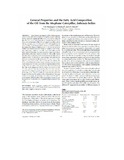General Properties and the Fatty Acid Composition of the Oil from the Mophane Caterpillar, Imbrasia belina

View/
Date
1998Author
Motshegwe, S.M.
Holmback, J.
Yeboah, S.O.
Publisher
AOCS Press. http://www.springerlink.com/content/0003-021XType
Published ArticleMetadata
Show full item recordAbstract
A preliminary investigation of the bulk properties
of the oil from the edible mophane caterpillar (phane), Imbrasia
belina, showed a significant difference in the iodine values of
the oils from mature and young phane. Detailed analysis of the
fatty acid composition of the two oil samples was thus carried
out by capillary gas chromatography (GC) and complemented
with 1H and 13C nuclear magnetic resonance (NMR) studies to
investigate the degree of unstauration in the two oil samples.
While these studies showed that the oil samples from the mature
and young mophane caterpillar were much the same in
fatty acid composition, the data revealed a significant divergence
from a literature report on phane oil. This earlier report
puts the ratio of total saturated to total unsaturated fatty acids at
approximately 1:1 (48.2:48.8, in percentages) and estimates the
fatty acid composition for the major fatty acids as 16:0 (31.9%),
18:0 (15.2%), 18:1 (20.4%), 18:2 (9.9%), and 18:3 (19%). The
data collected from the present work, however, showed the fatty
acid composition for total saturated and total unsaturated fatty
acids to be 40.5 and 57.0%, respectively. This work estimated
the fatty acid composition for the major fatty acids as 16:0
(27.2%), 18:0 (12.3%), 18:1 (16.1%), 18.2 (10.7%), and 18:3
(29.0%). Thus, linolenic acid was the most abundant fatty acid
in the phane oil. The GC results of the present analysis were
largely corroborated by studies of the composition of fatty acid
classes in the phane oil estimated from integrals of 1H and 13C
NMR signals. Oils from other edible Lepidoptera larvae are also
known to be much richer in unsaturated than saturated fatty
acids.
